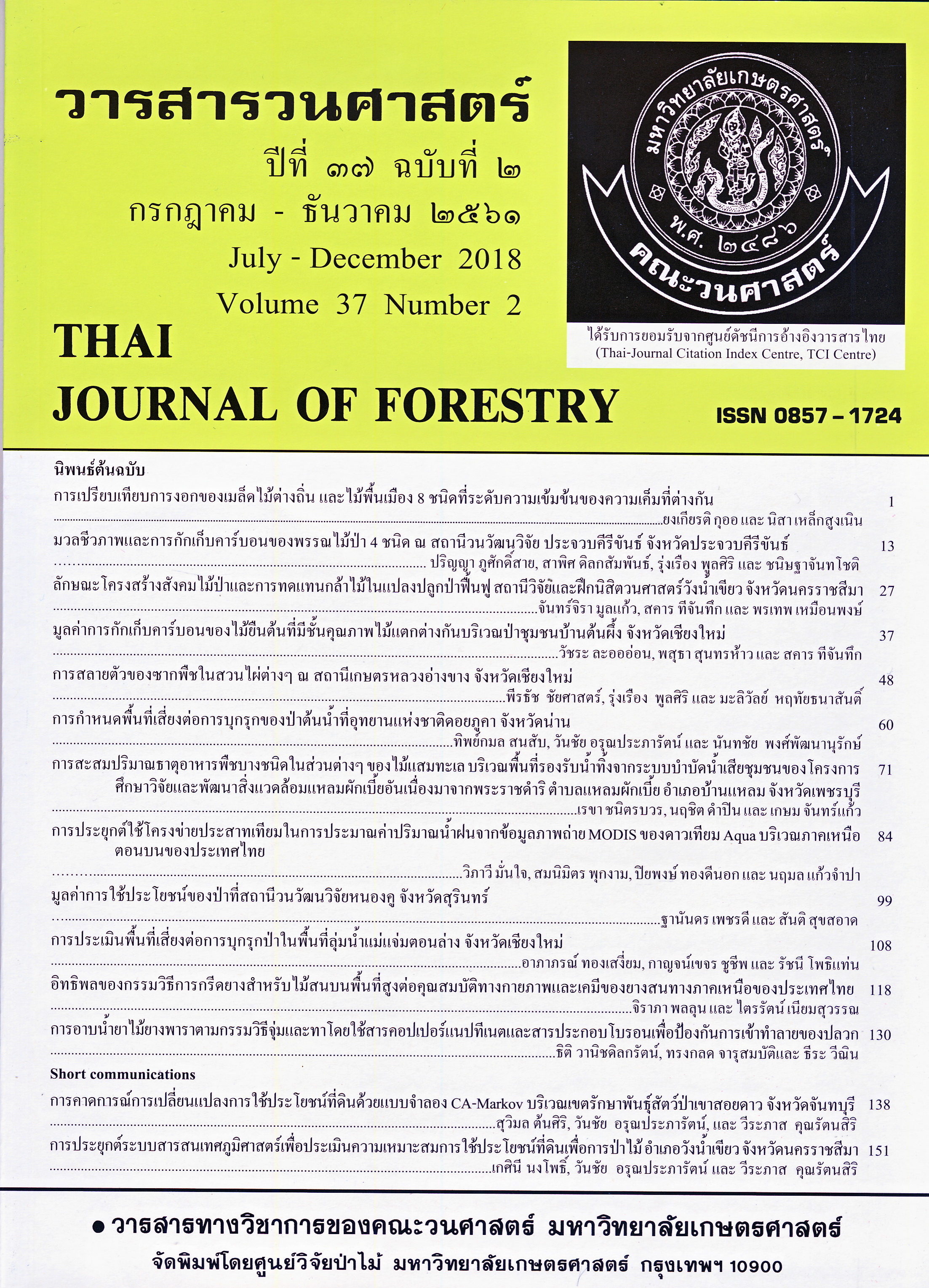อิทธิพลของกรรมวิธีการกรีดยางสำหรับไม้สนบนพื้นที่สูงต่อคุณสมบัติทางกายภาพและเคมีของยางสนทางภาคเหนือของประเทศไทย
Main Article Content
บทคัดย่อ
การวิจัยครั้งนี้มีวัตถุประสงค์เพื่อศึกษากรรมวิธีการเก็บยางสนที่เหมาะสมทั้งด้านปริมาณและคุณภาพเพื่อการนำไปใช้ประโยชน์ในรูปแบบต่างๆ โดยทำการทดลองที่สถานีวนวัฒนวิจัยอินทขิล อำเภอแม่แตง จังหวัดเชียงใหม่ ซึ่งทำการเก็บยางสนตั้งแต่เดือนมกราคม-พฤษภาคม พ.ศ. 2560 ใช้แผนการทดลองแบบสุ่มสมบูรณ์ มีปัจจัยการทดลอง 3 ปัจจัย คือ 1) รูปแบบของต้นสน ได้แก่ สนสองใบ สนสามใบ สนโอคาร์ปา สนคาริเบีย สนเทคูนูมานี อายุ 30 ปี และสนคาริเบียอายุ 10 ปี 2) กรรมวิธีการเก็บยางสน ได้แก่ กรรมวิธีการกรีดเปลือกและวิธีการเจาะรู 3) การใช้สารกระตุ้น ได้แก่ ไม่ใส่สารกระตุ้น ใส่กรดซัลฟูริกที่ความเข้มข้นร้อยละ 40 และ 60 หลังจากนั้นทดสอบคุณสมบัติทางกายภาพและคุณสมบัติทางเคมีของยางสน
ผลการศึกษาพบว่า กรรมวิธีการกรีดเปลือกให้ปริมาณยางสนมากกว่าการเจาะรู โดยชนิดสนที่ให้ปริมาณยางสนมากที่สุด คือ สนสองใบและสนคาริเบีย ตามลำดับ ในการใช้สารกระตุ้นด้วยกรดซัลฟูริกพบว่า ที่กรดซัลฟูริกความเข้มข้นร้อยละ 40 และ 60 ส่งผลให้ยางสนมีปริมาณเพิ่มมากขึ้น คุณสมบัติทางกายภาพของยางสนมีลักษณะเป็นของเหลว เหนียว มีสีเหลืองอำพัน และมีกลิ่นฉุน ค่าความถ่วงจำเพาะของยางสนแต่ละชนิดมีค่าใกล้เคียงกันประมาณ 1.08 และองค์ประกอบหลักทางเคมีของยางสนที่พบมากที่สุด คือ สารอัลฟาไพนีน ยกเว้นยางสนเทคูนูมานีที่มีสารเดลต้าแครีนมากที่สุด
Downloads
Article Details
ข้าพเจ้าและผู้เขียนร่วม (ถ้ามี) ขอรับรองว่า ต้นฉบับที่เสนอมานี้ยังไม่เคยได้รับการตีพิมพ์และไม่ได้อยู่ในระหว่างกระบวนการพิจารณาตีพิมพ์ลงในวารสารหรือสิ่งตีพิมพ์อื่นใด ข้าพเจ้าและผู้เขียนร่วม (ถ้ามี) ยอมรับหลักเกณฑ์และเงื่อนไขการพิจารณาต้นฉบับ ทั้งยินยอมให้กองบรรณาธิการมีสิทธิ์พิจารณาและตรวจแก้ต้นฉบับได้ตามที่เห็นสมควร พร้อมนี้ขอมอบลิขสิทธิ์ผลงานที่ได้รับการตีพิมพ์ให้แก่วารสารวนศาสตร์ คณะวนศาสตร์ มหาวิทยาลัยเกษตรศาสตร์ กรณีมีการฟ้องร้องเรื่องการละเมิดลิขสิทธิ์เกี่ยวกับภาพ กราฟ ข้อความส่วนใดส่วนหนึ่ง หรือ ข้อคิดเห็นที่ปรากฏในผลงาน ให้เป็นความรับผิดชอบของข้าพเจ้าและผู้เขียนร่วม (ถ้ามี) แต่เพียงฝ่ายเดียว และหากข้าพเจ้าและผู้เขียนร่วม (ถ้ามี) ประสงค์ถอนบทความในระหว่างกระบวนการพิจารณาของทางวารสาร ข้าพเจ้าและผู้เขียนร่วม (ถ้ามี) ยินดีรับผิดชอบค่าใช้จ่ายทั้งหมดที่เกิดขึ้นในกระบวนการพิจารณาบทความนั้น”
เอกสารอ้างอิง
ประดิษฐ์ หอมจีน. 2540. การปลูกสร้างสวนป่าไม้สนในประเทศไทย. ส่วนวนวัฒนวิจัยสำนักวิชาการป่าไม้ กรมป่าไม้, กระทรวงเกษตรและสหกรณ์.
วนิดา สุบรรณเสณี. 2530. การศึกษาอุตสาหกรรมยางสนในประเทศไทย. สำนักงานเงินทุนหมุนเวียน ค้นคว้าทดลองเกี่ยวกับป่าสน กองวิจัยผลิตผลป่าไม้, กรมป่าไม้.
วนิดา สุบรรณเสณี และ มยุรี ดวงเพชร. 2535. การเจาะยางสนแบบเปิดเปลือกโดยใช้กรดเร่ง. น.39-95. ใน รายงานการวิจัยของป่าปีงบประมาณ 2535. กรมป่าไม้, กระทรวงเกษตรและสหกรณ์.
สำนักงานมาตรฐานผลิตภัณฑ์อุตสาหกรรม. 2550. มาตรฐานอุตสาหกรรมชันสน. มอก. 480-2550.
Availability Reliability and Security, 2007. Brazilian association of resin tapping industries. Available Source: http://www.aresb.com.br/, April 17, 2018.
Cheng, S.S., C.Y. Lin, M.J. Chung, Y.H. LIU, C.G. Huang and S.T. Chang. 2013. Larvicidal activities of wood and leaf essential oils and ethanolic extracts from Cunninghamia konishii Hayata against the dengue mosquitoes. Industrial Crops and Products 47 (1): 310-315.
Coppen, J.J.W. and G.A. Hone. 1995. Gum naval Stores: Turpentine and Rosin from Pine Resin. Food and Agriculture Organization of the United Nations, Rome.
Goodger, J., T.S. Choo and I. Woodrow. 2007. Ontogenetic and temporal trajectories of chemical defence in a cyanogenic eucalypt. Oecologia 153 (4): 799-808.
Khamyong, S., N. Anongrak and S. Sumanochitraporn. 2014. Role of a Pine (Pinus kesiya) Plantation on Water Storage in the Doi Tung Reforestation Royal Project, Chiang Rai Province, Northern Thailand. Thai J. For. 33 (3): 75-87.
Matan, N. and S. Ketsa. 2012. Effect of heat curing on antifungal activities of anise oil garlic oil against Aspergillus niger on rubberwood. International Biodeterioration and Biodegradation 75 (1): 150-157.
Missio, A.L., B.D. Mattos, P.H.G. Cademertor, T.V. Lourencon, J. Labidi and D.A. Gatto. 2015. The effect of oleoresin tapping on physical and chemical properties of Pinus elliottii wood. Sci. For., Piracicaba 43 (107): 721-732.
Rodrigues-Correa, K.C.S., J.C. Lima, and A.G. Fett-Neto. 2013. Oleoresins from Pine: Production and Industrial Uses. Plant Physiology Laboratory, Center for Biotechnology and Department of Botany, Federal University of Rio Grande do Sul, Brazil.
Sharma, K.R. and C. Lekha. 2013. Tapping of Pinus Roxburghii (Chir Pine) for Oleoresin in Himachal Pradesh India. Advances in Forestry Letters (AFL) 2 (3): 51-55.


